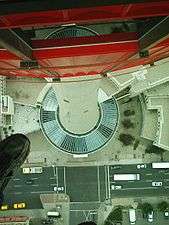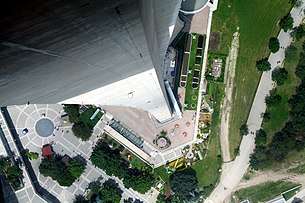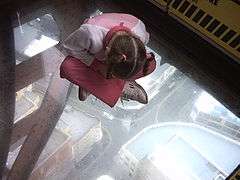Glass floor
Glass floors are made with transparent glass when it is useful to view something from above or below; whereas translucent glass is used when there is no need to view through. In either case, toughened glass is usually chosen, for its durability and resistance to breakage.
%2C_which_recently_opened_at_the_Gricignano_Support_Site.jpg)
Flooring
Translucent floors are sometimes set into outdoor sidewalks and pavements, or the floors of well-lit interior spaces, to daylight the space below. These are generally called pavement lights, and have a long history.[1]
Glass as a flooring material is used in both residential and commercial structures. Special hollow glass blocks known as '"glass pavers" are often used in combination with a metal frame. Glass floors are often lit from below with natural or artificial light, or may be treated as ordinary floor surfaces illuminated from above.
A German manufacturer of squash court floors has diversified into making glass floors for other sports, such as basketball. Their glass floors usually are translucent rather than transparent, and the line markings are indicated by illumination with LEDs below the floor.[2]
On occasion, transparent display cases are built into the floor, such as in the Museum of Sydney (in Sydney, New South Wales, Australia), where the remains of drains and privies are shown in their original context, along with other archeological artifacts.[3]
Tourist attractions
Usually made of a toughened glass which is also laminated for structural strength, a transparent floor is most commonly used as a tourist attraction. Glass-bottom boats are popular for allowing a better view into the water.
At 4000 feet (1219 m), the highest glass floor above ground is the novel outdoor application of the Grand Canyon Skywalk, operated by the Hualapai Indian tribe. The highest above ground level in a freestanding structure is in Lotte World Tower in Seoul, South Korea at 1,568 feet (478 m).[4]
In May 2014, the top layer of a glass floor spontaneously shattered in "the Ledge", a popular tourist attraction more than 1,500 feet (460 m) above street level, near the top of the Willis Tower in Chicago. Spokespersons for the architect (Skidmore, Owings & Merrill) and the tower management said that the broken glass was a protective layer, and that two other slabs of glass beneath it were strong enough to prevent anybody falling through.[5][6]
Some new planetariums now feature a glass floor, which allows spectators to stand near the center of a sphere surrounded by projected images in all directions, giving the impression of floating in outer space. For example, a small planetarium at AHHAA in Tartu, Estonia features such an installation, with special projectors for images below the feet of the audience, as well as above their heads.[7]
Use for study
Scientific studies of locomotion and gait have used glass floors to enable views from all angles.
Glass floors have also been used by artists to study foreshortening. The surrealist painter Salvador Dalí had one built to help him with the dramatic perspectives in his artwork.[8]
Observatories with glass floors
 Calgary Tower, Calgary, Alberta, Canada
Calgary Tower, Calgary, Alberta, Canada
 Spinnaker Tower, Portsmouth, England
Spinnaker Tower, Portsmouth, England- Ostankino Tower, Moscow, Russia
- Tokyo Tower, Tokyo, Japan
 Blackpool Tower, Lancashire, England
Blackpool Tower, Lancashire, England Tower Bridge, ?
Tower Bridge, ?
Notes
- Institute for Public Service, Seattle University, Marie Wong; et al. (2011), Seattle Prism Light Reconnaissance Study (PDF)CS1 maint: multiple names: authors list (link)
- "The Floor of the Future". ASB GlassFloor. ASB Systembau GMBH. Retrieved 2014-06-04.
- "Museum of Sydney Guidebook". Sydney Living Museums. Historic Houses Trust of NSW. Archived from the original on 2014-01-10. Retrieved 2014-01-03.
Underfloor: The remains of first Government House’s drains and privies are exposed below the floor. Also displayed is a selection of relics, ruins and rubbish from the house retrieved by archaeologists in the 1980s.
- "Highest glass-floor observation deck". Guinness World Records. Retrieved 2019-12-08.
- Campbell-Dollaghan, Kelsey (May 29, 2014). "The Willis Tower's 103rd Floor Glass Skydeck Cracked Last Night". Gizmodo. Gizmodo.com. Retrieved 2014-06-04.
- Coating on Willis Tower Skydeck's Ledge Cracks Under Tourists
- Aru, Margus (March–June 2012). "Under One Dome: AHHAA Science Centre Planetarium". Planetarian: Journal of the International Planetarium Society. 41 (2): 57. Retrieved 2014-06-04.
- Ades, ed. by Dawn (2000). Dalí's optical illusions : [Wadsworth Atheneum Museum of Art, January 21 - March 26, 2000 : Hirshhorn Museum and Sculpture Garden, April 19 - June 18, 2000 ; Scottish National Gallery of Modern Art, July 25 - October 1, 2000]. New Haven CT: Yale Univ. Press. pp. 17–18. ISBN 978-0300081770.CS1 maint: extra text: authors list (link)
External links
- Glass Floor Heliobus Applications of glass flooring